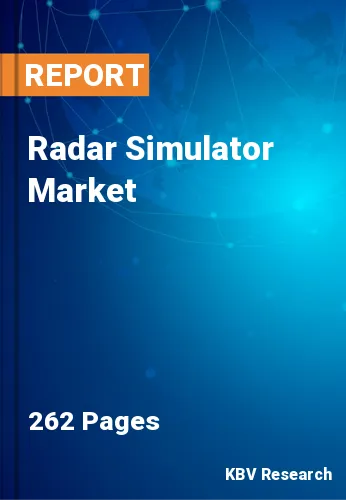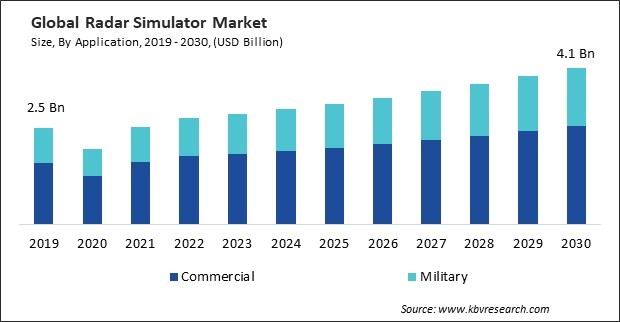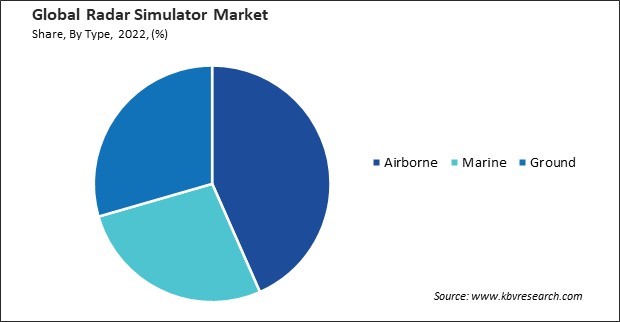
The Global Radar Simulator Market size is expected to reach $4.1 billion by 2030, rising at a market growth of 5.3% CAGR during the forecast period.
Modern vehicles often integrate multiple sensors, including radar, lidar, and cameras, to enhance perception and decision-making capabilities. Radar simulators contribute to sensor fusion testing, allowing engineers to evaluate how radar data aligns with information from other sensors. Consequently, the Automobile segment would generate approximately 26.30% share of the market by 2030. This is crucial for ensuring a comprehensive and accurate perception of the vehicle's surroundings. Radar vehicle sensors use sophisticated algorithms to process raw data and make decisions. Radar simulators assist in verifying and validating these algorithms by generating simulated radar returns based on different scenarios. This helps identify and address potential issues in the algorithms before deployment in actual vehicles.

Advancements in radar technology have led to the development of highly complex radar systems, including phased-array radars, synthetic aperture radars, and multifunctional radars. The increasing complexity poses challenges for training personnel to operate and maintain these systems effectively. Radar simulators offer a targeted and customized training platform, allowing operators to focus on specific radar functionalities and scenarios, such as electronic warfare, target tracking, and signal processing. Moreover, Realistic training scenarios enable radar operators to experience and navigate situations that closely mirror real-world conditions. This enhances their preparedness to handle complex scenarios, emergencies, and unexpected events, ensuring they can respond effectively in operational environments. Therefore, the increasing need for realistic training scenarios is a significant driver behind expanding the market.
However, the substantial costs associated with radar simulator development and integration can limit access for smaller defense organizations or entities with limited budgets. This lack of accessibility may hinder these entities from adopting advanced radar simulator technologies, potentially leading to a disparity in training capabilities among defense forces. Developing a radar simulator requires significant financial investments in research, technology, and skilled personnel. Due to the above factors, market growth will be hampered in the coming years.
 Drivers
Drivers  Restraints
Restraints On the basis of application, the market is divided into military and commercial. The military segment garnered a significant revenue share in the market in 2022. Military forces often operate in joint and coalition environments where interoperability is crucial. Radar simulators facilitate joint training exercises by simulating different radar systems and platforms. This helps military units practice coordination and communication with diverse radar assets in a simulated battlespace. When military forces upgrade or transition to new radar systems, simulators assist in training personnel on the new equipment. This ensures a smooth transition, minimizes downtime, and maximizes the effectiveness of the upgraded radar systems.
Under commercial, the market is further categorized into aviation, automobiles, and others. In 2022, the aviation segment generated the highest revenue share in the market. Radar simulators enable the creation of scenario-based training exercises tailored to specific situations, such as airshows, military operations, or special events. Radar simulators incorporate realistic weather scenarios, allowing pilots and air traffic controllers to practice responding to adverse weather conditions such as thunderstorms, turbulence, or low visibility. This type of training enhances decision-making skills and situational awareness in challenging weather environments.
By type, the market is classified into marine, airborne, and ground. In 2022, the airborne segment registered the largest revenue share in the market. The increasing complexity of airborne radio detection and ranging systems demands comprehensive training simulations to ensure operators' proficiency and the equipment's effectiveness. This is particularly evident in the aviation industry, where radio detection and ranging systems are critical in navigation and safety. Radar simulators play a critical role in military aviation by providing pilots with the necessary training to execute a wide range of missions, such as surveillance and aerial combat. Realistically, simulating airborne radar systems allows pilots to hone their skills and decision-making processes in a controlled environment.

On the basis of components, the market is segmented into hardware and software. The software segment acquired a substantial revenue share in the market in 2022. Technological advancements in software technologies have developed sophisticated and feature-rich radar simulation programs that offer exceptional realism in training scenarios. The ability of these software solutions to accurately simulate a wide range of radio detection and ranging environments has contributed to their extensive implementation in numerous industries. The capacity to accurately simulate intricate radio detection and ranging operations increases the efficacy of training, thereby propelling the demand for such software even higher.
Based on product, the market is fragmented into system testing and operator training. In 2022, the operator training segment held the highest revenue share in the market. The increasing awareness of the pivotal significance attributed to proficient operators in optimizing the effectiveness and precision of radio detection and ranging systems in diverse sectors is stimulating the uptake of radar simulators. Investing in operator training programs is a priority for organizations in order to improve operational competence. Comprehensive training simulations are crucial in the defense sector, where precise radar operations are paramount. The utilization of simulator systems for radio detection and ranging empowers military personnel to engage in the preparation and strategic readiness of complex scenarios, including missile tracking and aerial surveillance.
Free Valuable Insights: Global Radar Simulator Market size to reach USD 4.1 Billion by 2030
Region-wise, the market is analysed across North America, Europe, Asia Pacific, and LAMEA. The Asia Pacific region acquired a substantial revenue share in the market in 2022. The surge in advanced radar training solutions can be attributed to the region's expanding defense expenditures, which are propelled by geopolitical considerations and modernization efforts. The adoption of radio detection and ranging simulators for training purposes has been facilitated by the substantial investments made by nations like China and India in military capabilities. Adoption of radio detection and ranging simulators for training personnel in the management of crises, including civil and natural emergencies, has also resulted from the Asia-Pacific region's increased emphasis on emergency response capabilities and disaster management.
| Report Attribute | Details |
|---|---|
| Market size value in 2022 | USD 2.8 Billion |
| Market size forecast in 2030 | USD 4.1 Billion |
| Base Year | 2022 |
| Historical Period | 2019 to 2021 |
| Forecast Period | 2023 to 2030 |
| Revenue Growth Rate | CAGR of 5.3% from 2023 to 2030 |
| Number of Pages | 262 |
| Number of Tables | 500 |
| Report coverage | Market Trends, Revenue Estimation and Forecast, Segmentation Analysis, Regional and Country Breakdown, Porter’s 5 Forces Analysis, Company Profiling, Companies Strategic Developments, SWOT Analysis, Winning Imperatives |
| Segments covered | Type, Component, Product, Application, Region |
| Country scope |
|
| Companies Included | Mercury Systems, Inc., Keysight Technologies, Inc., Cadence Design Systems, Inc., L3Harris Technologies, Inc., RTX Corporation, Adacel Technologies Limited, Cambridge Pixel Ltd., CAE Inc., Aechelon Technology, Inc., Buffalo Computer Graphics, Inc. |
By Application
By Type
By Component
By Product
By Geography
The Market size is projected to reach USD $4.1 billion by 2030.
Rising advancements in radar technology are driving the Market in coming years, however, High prices associated with research, development, and integration restraints the growth of the Market.
Mercury Systems, Inc., Keysight Technologies, Inc., Cadence Design Systems, Inc., L3Harris Technologies, Inc., RTX Corporation, Adacel Technologies Limited, Cambridge Pixel Ltd., CAE Inc., Aechelon Technology, Inc., Buffalo Computer Graphics, Inc.
The expected CAGR of this Market is 5.3% from 2023 to 2030.
The Hardware segment is leading the Market by Component in 2022 thereby, achieving a market value of $2.4 Billion by 2030.
The North America region dominated the Market by Region in 2022, and would continue to be a dominant market till 2030; thereby, achieving a market value of $1.3 Billion by 2030.
Our team of dedicated experts can provide you with attractive expansion opportunities for your business.
